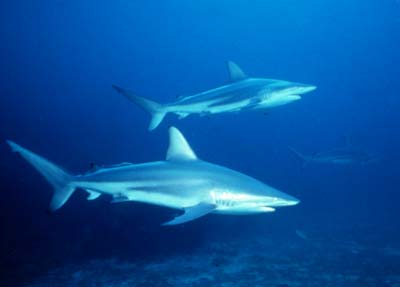
|
|
|
|
|
|
Shark Info (06-15-2001) |
Author |
|
Intro: |
Shark Info |
|
Main article: |
Shark Info |
|
Article 1: |
Fishing, fins and the lack of sufficient international controls |
Shark Info |
Article 2: |
Shark Info |
|
Article 3: |
Dr. E. K. Ritter |
|
Fact Sheet: |
Dr. E. K. Ritter |
|
Fact Sheet: Carcharhinus limbatus
Blacktip sharks are widely distributed in Florida and are the main species of shark involved in accidents. Worldwide their numbers have been extremely decimated due to increased overfishing and today they are an endangered species. The biology of the blacktip shark (Carcharhinus limbatus)DescriptionBlacktip sharks have a relatively pointed snout and their first dorsal fin is high. They have small eyes and conspicuously long gill slits. Contrary to other representatives of their family they have no interdorsal ridge between the first and second dorsal fin. Depending on where they are, their basic color changes from light to dark, whereby the bands on the flanks always remains clearly visible. Despite their name the tip of the anal fin is not black but either gray or white. Size and AgeBlacktip sharks belong to the more short-lived species, having an estimated life span of 12 years. Their average length is approximately 150 cm, their average weight approximately 18 kg, whereby animals measuring 250 cm have also been sighted. FeedingTheir main prey are fish, e.g. sardines, herring, mackerels or even flatfish. On rare occasions the remains of crustaceans, mollusks or even small sharks have been found in stomach analyses (soupfin sharks, sharp-nose sharks, young soupfin sharks, etc.). ReproductionAs with all species in the Carcharhinidae family - except the tiger shark (Galeocerdo cuvier) - blacktip sharks are viviparous and have a yolk-sac placenta. They usually bear between four and seven young, with large females being able to bear up to ten pups. The gestation period its between 10 and 11 months and the size of the pups at birth is approximately 40 to 70 cm. Because of their short life span, blacktip sharks mature at the relatively early age of four. Research has shown that the females only bear young every two years. The pups are born in the coastline regions and grow rapidly. DistributionBlacktip sharks are distributed worldwide in tropical and subtropical oceans. They are usually found on the continental shelves, but have also been seen around Hawaii, the Galapagos and other island groups in the Pacific. BehaviorBlacktip sharks live mostly on the surface and are seldom found in depths over 30 meters. They are also frequently seen in front of estuaries and bays where larger saline differences prevail. They belong to those species which often spring out of the water while hunting or while trying to free themselves of remoras. Single populations of this species undergo longer migrations so that they are found in certain locations frequently during specific times of the year, but the migrating populations are separated according to age and stages of gestation. Danger to humansAlthough blacktip sharks, at least in Florida, is the species of shark most commonly involved in accidents, the bites of these relatively small sharks do not pose any real danger to humans. Degree of endangermentBlacktip sharks are fished commercially worldwide and must be considered an endangered species. May be published only by indicating the source: Shark Info / Dr. Erich K. Ritter |
|
|
|
|
|
|||||
